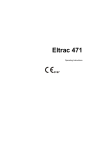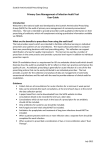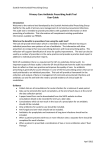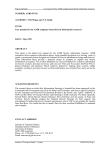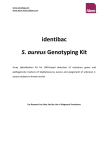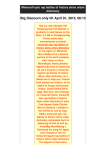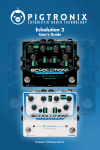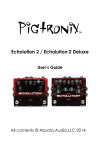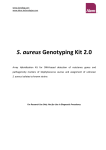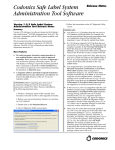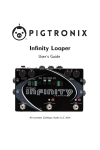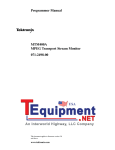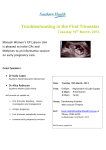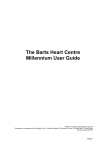Download User`s Manual - Australian Society for Antimicrobials
Transcript
AUSTRALIA NEW ZEALAND COOPERATIVE ON OUTCOMES IN STAPHYLOCOCCAL SEPSIS VERSION 2 USER’S MANUAL October 2008 ANZCOSS Version 2 User’s Manual October 2008 1 ANZCOSS Co-ordinator Prof John Turnidge SA Pathology at the Women’s and Children’s Hospital North Adelaide SA 5006 Australia Email: [email protected] Ph: 61 (0)8 8161 6873 Fax: 61 (0)8 81616189 ANZCOSS Data Administrator Mrs. Despina Kotsanas Infection Control Scientist Infectious Diseases Dept Monash Medical Centre Clayton Victoria 3168 Australia Email: [email protected] Ph: 61 (0)3 9594 6851 Fax: 61 (0)3 9594 4533 ANZCOSS Version 2 User’s Manual October 2008 2 Contents Contents ..........................................................................................................................................................................3 Introduction....................................................................................................................................................................4 Background ................................................................................................................................................................4 Objective ....................................................................................................................................................................4 Data Management .....................................................................................................................................................4 Data entry...................................................................................................................................................................4 Data access .................................................................................................................................................................5 Patient Confidentiality ..............................................................................................................................................5 Storage and backup...................................................................................................................................................5 Audits..........................................................................................................................................................................5 Analysis .......................................................................................................................................................................5 Data Collection ..............................................................................................................................................................6 Entry criterion ...........................................................................................................................................................6 Positive blood culture for Staphylococcus aureus ..................................................................................................6 ANZCOSS Participant Staff....................................................................................................................................6 Data collection...........................................................................................................................................................6 Ethics ..........................................................................................................................................................................6 Data requirements and notes .......................................................................................................................................7 Data entry fields ........................................................................................................................................................7 1. Web data entry ..................................................................................................................................................7 2. Data set required on each patient ..................................................................................................................7 Save case .....................................................................................................................................................................9 Denominator data: Occupied Bed Days............................................................................................................. 10 Store all isolates (one per patient episode) ......................................................................................................... 10 Newsletter updates................................................................................................................................................. 11 Rankings and Funnel plots ................................................................................................................................... 11 Steering Committee ............................................................................................................................................... 11 Appendix 1 .................................................................................................................................................................. 12 Blood Stream Infections (definitions) ..................................................................................................................... 12 1. Diagnosis of blood stream infection............................................................................................................... 12 2. Onset.................................................................................................................................................................... 12 3. Risk Factors ........................................................................................................................................................ 12 Appendix 2 .................................................................................................................................................................. 13 Data Collection Form (Example)............................................................................................................................. 13 Appendix 3 .................................................................................................................................................................. 15 Web Data Entry (example)........................................................................................................................................ 15 Appendix 4 .................................................................................................................................................................. 18 Ethics............................................................................................................................................................................ 18 Cover Letter (Example)......................................................................................................................................... 18 Description document ............................................................................................................................................... 19 Participating Sites to October 2008 ......................................................................................................................... 21 ANZCOSS Version 2 User’s Manual October 2008 3 Introduction Background Staphylococcal sepsis remains a significant healthcare problem worldwide, both in the community and in hospital practice. There is abundant literature demonstrating that outcomes are suboptimal for some cases of invasive staphylococcal infection. Organism factors known to impact on outcomes include resistance, especially methicillin resistance, and toxin production such as TSST-1 and PVL. The current estimates of crude mortality are around 20%, with at least half of that considered to be attributable mortality. To understand the local epidemiology of severe staphylococcal disease in Australia and New Zealand a local cooperative has been established; the Australian New Zealand Cooperative on Outcomes in Staphylococcal Sepsis (ANZCOSS). ANZCOSS operates under the auspices of the Australian Society for Antimicrobials (ASA), a scientific/professional organisation established in 1999 to further the study and application of antimicrobials in Australia. Objective The principal objective is to gather basic data on outcomes. Over 15 months of preliminary national data on outcomes of staphylococcal sepsis has been collected by October 2008. Participating institutions are expected to collect basic demographic, risk factor and outcome data on patients with staphylococcal sepsis seen at their sites on a continuous basis. To date 25 institutions from Australia and 4 from New Zealand have contributed data. Future studies and interventions are planned for the next stage of this study. Data Management Cases will be identified initially in the ANZCOSS participants associated laboratory through a positive blood culture for Staphylococcus aureus. The nature of the demographic, risk factors and outcome data required is such that ANZCOSS participant staff will need to gather the required information through a range of means specified in the Data Collection instructions. These include methods such as (i) case note review, (ii) discussion with the clinical staff caring for the patient, (iii) review of laboratory information system (LIS), and (iv) review of patient information system (PIS), or any combination of these. Overall, the data being collected are those which would normally be encountered or sought as part of direct or consultative patient management and follow-up. For outcome data, ANZCOSS participant staff must not contact the patient of family directly if they have been unable to determine the outcome through the specified means. Data entry Data will be entered at each participating site by ANZCOSS participating staff as in the ANZCOSS document: ANZCOSS manual. The data will be entered directly onto a web database located at www.asainc.net.au/anzcoss/. Each site will have a unique code that requires an initial set up and password ANZCOSS Version 2 User’s Manual October 2008 4 for login. Only approved staff from each participating site can enter data on screen. When an entry is completed a green tick appears on the left hand side of that entry on the summary page. Editing is still allowed even if entry is complete. At present your contribution is entirely voluntary. Data access Each member of ANZCOSS participant staff will have access to the raw data on the web database for their own site only. Site downloads can be provided by the data administrator directly to a spreadsheet on request. Access to the whole set of raw data will only be accessible by” the Data Administrator (Despina Kotsanas, Monash Medical Centre), the ANZCOSS Co-ordinator (John Turnidge, Women’s and Children’s Hospital) and the webmaster (Andrew Hollander, ActiveOrg, Perth). Patient Confidentiality In order to provide adequate patient descriptors, the following information will be entered for each patient: A. Date of birth, and B. Sex., C. Ethnicity and D. Postcode of residence. To ensure that subsequent queries of the data by the Data Administrator can be adequately followed up, the specimen Episode Identifier of the blood culture that fulfilled the study entry criterion will be stored. This number is unique, but will not allow identification of a patient to any staff outside the participating site. Where the laboratory information system might allow access via the specimen Episode Identifier outside the participating site, those sites will generate a unique identifier on the web database and keep a separate password-only accessible electronic record that will allow cross-reference the full results. Postcode of patient residence will be collected to assist in defining regional prevalence differences in staphylococcal sepsis rates. Because of the limited scope of the data being collected, with the patient only able to be identified by the participating staff at their participating site, patient consent is not required. Storage and backup Data will be stored on the web database server and backed up regularly. Spreadsheet downloads of the full database with the Episode Identifier will be made periodically, but only made available to the Data Administrator and Co-ordinator. Participants who wish to view/access data from sites other than their own will be sent the relevant spreadsheet of data with the Episode Identifier removed and the individual’s sites encoded to de-identify them. Audits Audits are conducted several times a year or as requested by the Data Administrator. They are conducted to clean up any obvious errors; check inconsistencies such as double entries and cross check the consistency between susceptibility and treatment data. Analysis Analysis will examine: a. Type of acquisition (hospital versus community) b. Proportions community-acquired (as opposed to community-onset) c. Outcomes at 7 and 30 days, overall and by susceptibility and principal treatment d. Rates per occupied bed day ANZCOSS Version 2 User’s Manual October 2008 5 Data Collection Entry criterion Positive blood culture for Staphylococcus aureus It is recognised that this does not capture every serious staphylococcal sepsis, but will capture the majority. It is simple and unequivocal. Rarely, S. aureus can be a blood culture contaminant. If in the clinical judgement of the participant (see BSI definitions, Appendix 1) contamination is the likely explanation for a positive blood culture, then these should be excluded from the data collection. However, if antistaphylococcal treatment has been commenced “just in case” then the episode should be included. ANZCOSS Participant Staff ANZCOSS participants are medical ± infection control staff from Microbiology/Infectious Diseases departments at the Participating Sites. Data collection Cases will mostly be identified initially in the ANZCOSS participants associated laboratory through a positive blood culture for Staphylococcus aureus. The participating site must be in a position to collect ALL the data listed in Data Requirements where available. It is expected that this information will be gathered by methods such as (i) Case note review, (ii) Discussion with the clinical staff caring for the patient, (iii) Review of the laboratory information system (LIS), and (iv) Review of the patient information system (PIS), or any combination of these. Information on outcome is essential at 7 days and at 30 days. (See Appendix 2 for Data Collection Form and Appendix 3 for Web entry format) This data can be obtained through the PIS or LIS, case note review or contact with the caring clinicians. Patients or their families are not be contacted after discharge directly to obtain outcome information. Denominator data (occupied bed days over the period of data entry) can be entered at the end of the collection period when requested by the data administrator. Ethics Each institution should seek a waiver/ exception from their hospital Human Research Ethics Committee of this quality assurance study. This will vary for each institution. (See Appendix 4 as an example). ANZCOSS Version 2 User’s Manual October 2008 6 Data requirements and notes Data entry fields Data will be entered at each participating site by ANZCOSS participating staff. 1. Web data entry 1. Website: http://www.asainc.net.au/anzcoss/ This can also be found as a link on the ASA (Australian Society for Antimicrobials) website. 2. Enter institution password You will be required to set an institution password on the second screen at the time of initial access. This screen will be bypassed subsequent to you changing your password 3. Enter your Surname (name of person entering data) 2. Data set required on each patient 1. Episode Identifier This is needed in order for the Data Administrator to be able to check on particular entries for data integrity and validity. The episode identifier should be the laboratory accession number of the positive blood culture. If you are unable to use the accession number, please create a secure electronic master list that cross-references the ID number system you have used so that you are able to identify the patient and check any patient details if asked by the Data Administrator. Do not use the patient’s medical record number. Do not report again if another episode occurs within a 14 day period, regardless if primary medical condiction or treatment conditions may have changed. If patient has cleared this episode (>14 days) and contracted another S. aureus bacteraemia, either relapse or re-infection (mostly occurs when device related), then you may enter again. 2. Date of birth (dd.mm.yyyy) 3. Sex M or F 4. Postcode of patient residence This field in included in order to get a picture of incidence by demographic area 5. Ethnicity (Choose one) This is the principal ethnic background of the patient as indicated in the medical records, not their country of birth/origin. The list has been modified from the New Zealand statistical standard, which is more relevant than the Australian statistical standard to the epidemiology of resistant and PVL positive strains and possible clinical outcomes. 6. BC collection date This is the date of collection of first positive blood culture set in an episode. This is taken to be the time of entry into the study for the purposes of analysis ANZCOSS Version 2 User’s Manual October 2008 7 7. Date of admission (dd.mm.yyyy) Not admitted (Tick) 8. Date of discharge (if admitted) (dd.mm.yyyy) This equates to the date of death at ≤30 days. If transferred to another hospital, has to include the time they spent there. 9. Susceptibility (Choose one) We do not want or need the antibiogram at this stage. Instead we have listed the five “types” which might be treated with different antimicrobials. For the purposes of choosing the likely type of MRSA, the non-ß-lactam antibiotics are erythromycin/clindamycin, tetracycline, gentamicin, ciprofloxacin, co-trimoxazole or trimethoprim, fusidic acid and rifampicin. (You do not need to have tested all of these necessarily to decide.) Notes 1. EMRSA -15-like are those that are susceptible to tet, cotri, gen but resistant to cip; ery often but not always tests as resistant. 2. Enter BORSA (Borderline Oxacillin resistant SA) as Methicillin susceptible. When there are 2 strains of S. aureus in one blood culture collection, choose the more resistant profile. 10. Onset and Risk factors Enter data for ALL S. aureus episodes (previously we only asked this question for community-onset infections. Onset will be determined at analysis from collection and admission dates supplied. PLEASE NOTE THE QUESTION ABOUT PLACE OF ONSET IS JUST THAT. IT IS NOT ABOUT WHETHER YOU CONSIDER THIS EPISODE IS HOSPITAL-AQUIRED OR HEALTH-CARE ASSOCIATED The questions related to hospitalisation, surgery and dialysis will identify health-care related infections, close contact with MRSA are risk factors for MRSA exposure, and residence in LTCF and IVDU for other risk groups. These will be used as factors in the data analysis. 11. Device related Most of the common devices are listed. If it was device-related and the device that was the source is not in the list, choose “Other”. You are not required to specify what the “Other” device is. It is expected that the answer would be “Unknown”. Frequently, the answer is “Uncertain”, especially when the device itself can’t be or hasn’t been sampled, or there is more than one device. If the device was more than likely involved, then we ask you to choose a device from the list. If it is unlikely that the device is involved, we ask you to choose “ No- not device-related” PICC line-associated bacteraemia should be coded as “central intravascular line”. 12. Principal clinical manifestation of staphylococcal sepsis Nominate the “Principal” manifestation, that is, the most prominent feature of the infection. It is recognised that there is often more than one clinical manifestation. Please choose the one that according to your clinical judgement is the “Principal” one. If the manifestation is not in the list, choose “Other”. You are not required to specify what the “Other” manifestation is. ANZCOSS Version 2 User’s Manual October 2008 8 13. Admission to Intensive Care Answer Yes or No and add date (dd.mm.yyyy) if patient was admitted to Intensive Care for management of S. aureus bacteraemia during the 30 day follow period (including onset of bacteraemia in ICU). 14. Principle treatment Choose the main agent used for definitive IV treatment, i.e. after susceptibility results and not their initial IV therapy necessarily. Option to use “not treated” for patients who have died before therapy has commenced, have refused treatment or from who treatment was withheld. 15. Outcome at 7 days after collection of blood culture You must provide this for any of the other data to be useful. The default position is “Survived”. i.e. we assume that the patient survived unless you specify otherwise. Note that we are asking for what is called crude mortality, i.e. death from any cause in the 7 days following collection of the initial blood culture. You are not required to assess so-called attributable mortality, i.e. you do not need to decide if the S. aureus infection was the cause of death. It is the deliberate decision of the cooperative not to force participants to decide on attributable mortality due to the difficulty of defining objective criteria for making that decision. 16. Outcome at 30 days after collection of blood culture We strongly recommend that outcome at this time be sought. If the patient has been discharged prior to the 30 day mark, options for determining the 30 day outcome include review of medical records, outpatient appointment systems, blood or other specimen results or contact with the clinician who was undertaking care post-discharge. Save case On the bottom right is a button that allows you to save the case. If awaiting further data leave this incomplete. Once all information, including the 30 day outcome, has been entered mark as complete. This will result as the patient being marked as complete on the patient list summary screen with a GREEN tick. However, if you do need to change or correct data at a later stage you can go back and edit. ANZCOSS Version 2 User’s Manual October 2008 9 Denominator data: Occupied Bed Days This data need only be entered after the end of a defined data entry period. This is usually requested by the data administrator on an annual basis. It should cover the time from the date that the first patient was entered until the nominated end date, or the full year of data were entered from then. Enter Occupied Bed Days (OBDs) on the Right hand side of the summary screen for your institutions. Two rates are required: 1. TOTAL occupied bed days including emergency, renal, rehab, mental health etc. as provided by the hospital clinical information system. This rate will include all single and multiday stays. 2. Only MULTIDAY stays and this will be used to calculate Hospital onset MRSA rates. This is defined as a patient who stays overnight or longer. Store all isolates (one per patient episode) We are hopeful that a variety of laboratory studies will be conducted once the data on outcomes have been analysed. You will be notified about when and where to send isolates if that happens. ANZCOSS Version 2 User’s Manual October 2008 10 Newsletter updates All participants can access newsletter updates from the ANZCOSS website. FAQs are also covered in these updates. Rankings and Funnel plots All participating sites will be issued with a CODE (de-identified) and ranked by 30 day mortality as part of auditing. At this stage these data are not adjusted for age or category of hospital and does not contain error bars. This is provided in a Funnel plot which compares proportions (in this case mortality rates) with samples size of each site and contains 2 and 3SD statistical limits (the funnels) which are necessarily wider on the left hand side with the lower number of cases. The plot is funnel shaped with the “neck” of the funnel showing little spread among hospitals with the larger number of cases, and the “mouth” showing a wider spread for those that have a smaller number of cases. Participants can determine where they fit by reading their percentage mortality from their total cases. Each “dot” represents the mortality from one participant. Once again this data is NOT controlled for age. ANZCOSS 30d Mortality May 2008 30 Percentage Mortality 25 Data 20 Average 2SD limits 15 3SD limits 10 5 0 0 50 100 150 200 Number of cases Source: ANZCOSS data 06/05/08 Steering Committee A steering committee has been appointed to meet yearly and review data analysis, look at spin off trials and consider future publications on behalf of the ANZCOSS group. Study proposals can be made to this committee for access to data. ANZCOSS Version 2 User’s Manual October 2008 11 Appendix 1 Blood Stream Infections (definitions) 1. Diagnosis of blood stream infection Isolation of Staphylococcus aureus from blood stream automatically meets the criteria of a recognized pathogen. However, there are some circumstances where treatment has not been commenced and doctor is confident that this is a contaminant (i.e 1 out of 10 bottles and patient afebrile); this entry may be excluded from the study. 2. Onset An interpretation is no longer required by the participating site. This is to be determined using date of admission and collection at the time of data extraction and analysis. [In the analysis, hospital onset will be defined as blood cultures collected > 48 hours after admission and community onset as ≤ 48 hours or not admitted.] 3. Risk Factors Over the last 12 months, indicate whether there has been a history of the following risk factors. Answer for ALL cases. Hospitalisation (excluding admission for uncomplicated birth) Surgery Dialysis Residence in a long-term care facility Close contact with health-care associated MRSA* Close contact with community-associated MRSA* Intravenous drug abuse * e.g. household/institutional/work-related (e.g. health-care worker) contact with know or colonised or infected MRSA patients ANZCOSS Version 2 User’s Manual October 2008 12 Appendix 2 Data Collection Form (Example) AUSTRALIA NEW ZEALAND COOPERATIVE ON OUTCOMES IN STAPHYLOCOCCAL SEPSIS 1. Episode identifier: Laboratory Number of positive blood culture (for audit purposes): 2. Date of birth: 3. Sex: 4. Postcode: 5. Ethnicity (choose one) Australian Aboriginal/TSI East and SE Asian European (=Caucasian) Maori Middle Eastern/ Latin American/ African Pacific Islander South Asian Other 6. BC collection date: 7. Date of admission: 8. Date of discharge if admitted: not admitted (=Date of death if died at ≤ 30 days) 9. Susceptibility (choose one) Penicillin-susceptible Methicillin-susceptible Methicillin-resistant, multi-resistant (>2 non-ß-lactam classes, AUS-2/3-like) Methicillin-resistant, ciprofloxacin-resistant ± erythromycin-resistant only (EMRSA-15 like) Methicillin-resistant, other non-multi-resistant (community-MRSA like) 10. Onset and Risk factors Onset will be determined at analysis from collection and admission dates supplied: Hospital onset will refer to blood cultures collected>48 hours after admission (birth of neonate) or within 48 hours of discharge Community onset will refer to blood cultures collected≤48 hours after admission, or not admitted. Risk factors Over the past 12 months, indicate whether there has been a history of (please try to answer each question for ALL cases; more than one risk factor can be chosen) Hospitalisation (excluding admission for uncomplicated birth ) Yes No Unable to determine Surgery Yes No Unable to determine Yes No Unable to determine Dialysis Yes No Unable to determine Residence in a long-term care facility Yes No Unable to determine Close contact with health-care associated MRSA* Yes No Unable to determine Close contact with community-associated MRSA* Yes No Unable to determine Intravenous drug abuse * e.g. household/institutional/work-related (e.g. health-care worker) contact with know or colonised or infected patients ANZCOSS Version 2 User’s Manual October 2008 13 11. Device related Unknown No-Not device-related Yes-Central intravascular line Yes-Haemodialysis intravascular access device Yes-Orthopaedic device (e.g. joint replacement, nail or wire) Yes-Peripheral intravascular line Yes-Peritoneal dialysis catheter Yes-Urinary catheter Yes-Other local device (e.g. ventricular assist device) 12. Principal clinical manifestation of staphylococcal sepsis (choose one) CNS Infection (including epidural abscess) Deep abscess (es) excluding CNS abscess (es) Device infection without a secondary focus Device infection with a secondary focus Endocarditis, left-sided Endocarditis, right-sided Osteomyelitis/septic arthritis/discitis Pneumonia/empyema Sepsis syndrome (including toxic shock) Skin or skin structure infection including surgical and sternal wounds Other No focus 13. Admitted to Intensive Care Unit for management of staphylococcal bacteraemia (including onset of bacteraemia in ICU) No Yes Date: (dd.mm.yyyy) 14. Principal treatment (main agent used for definitive IV treatment, i.e. after susceptibility results) (choose one) Benzylpenicillin Cephazolin/Cephalothin Clindamycin/Lincomycin Co-trimoxazole Daptomycin Dicloxacillin Flucloxacillin Linezolid Meropenem/Imipenem Moxifloxacin Piperacillin-tazobactam Teicoplanin Ticarcillin-clavulanate Tigecycline Vancomycin Other Specify main agent (only one entry) Not treated 15. Outcome at 7 days after collection of blood culture (choose one) Survived Died 16. Outcome at 30 days after collection of blood culture (choose one) Survived Died Unable to determine ANZCOSS Version 2 User’s Manual October 2008 14 Appendix 3 Web Data Entry (example) Institution: 3MMC - Monash Medical Centre User Name: Despina Change Pwd Data Entry 1. Episode Identifier: U8288010 (Laboratory Number of positive blood culture, for audit purposes) 2. Date of Birth: 2.3.1980 (dd.mm.yyyy) 3. Sex: Female Male 4. Post Code: 3995 5. Ethnicity: Asian (East and SE Asian) Maori Asian (South Asian) Middle Eastern / Latin American / African Australian Aboriginal / TSI Pacific Islander European (Caucasian) Other 6. BC Collection: 14.10.2008 (dd.mm.yyyy) 7. Date of Admission: 13.10.2008 (dd.mm.yyyy) Not Admitted 8. Date of Discharge: (if admitted) (dd.mm.yyyy) (or Date of Death if died at up to 30 days) 9. Susceptibility: Penicillin-susceptible Methicillin-susceptible Methicillin-resistant, multi-resistant (>2 non ß-lactam classes) Methicillin-resistant, ciprofloxacin-resistant ± erythromycin-resistant only (EMRSA-15 like) Methicillin-resistant, other non-multi-resistant (community MRSA like) ANZCOSS Version 2 User’s Manual October 2008 15 10. Onset and Risk Factors: Onset will be determined at analysis from collection and admission dates supplied. Hospital Onset will refer to blood cultures collected > 48 hours after admission (birth of neonate) or within 48 hours of discharge. Community Onset Community onset will refer to blood cultures collected ≤ 48 hours after admission, or not admitted. Risk Factors Over the past 12 months, indicate whether there has been a history of (please try to answer each question for ALL cases; more than one risk factor can be chosen): a. Hospitalisation (excluding admission for uncomplicated birth) Yes No Unknown b. Surgery Yes No Unknown c. Dialysis Yes No Unknown d. Residence in a long-term care facility Yes No Unknown e. Close contact with health-care associated MRSA (*) Yes No Unknown f. Close contact with community-associated MRSA (*) Yes No Unknown g. Intravenous drug abuse Yes No Unknown * e.g. household/institutional/work-related (e.g. health-care worker) contact with know or colonised or infected patients. 11. Device Related: Unknown No - Not device-related Yes - Central intravascular line Yes - Haemodialysis intravascular access device Yes - Orthopaedic device (e.g. joint replacement, nail or wire) Yes - Peripheral intravascular line Yes - Peritoneal dialysis catheter Yes - Urinary catheter Yes - Other local device (e.g. ventricular assist device) 12. Principal clinical manifestation of staphylococcal sepsis: CNS Infection (including epidural abscess) Deep abscess(es) excluding CNS abscess(es) Device infection with a secondary focus Device infection without a secondary focus Endocarditis, left-sided Endocarditis, right-sided ANZCOSS Version 2 User’s Manual October 2008 16 Osteomyelitis / septic arthritis / discitis Pneumonia / empyema Sepsis syndrome (including toxic shock) Skin or skin structure infection including surgical and sternal wounds Other No focus 13. Admitted to Intensive Care Unit: for management of staphylococcal bacteraemia (including onset of bacteraemia in ICU) No Yes Date Addmitted: (dd.mm.yyyy) 14. Principal treatment (main agent used for definitive IV treatment, i.e. after susceptibility results): Benzylpenicillin Flucloxacillin Ticarcillin-clavulanate Cephazolin / Cephalothin Linezolid Tigecycline Clindamycin / Lincomycin Meropenem / Imipenem Vancomycin Co-trimoxazole Moxifloxacin Other (fill out below) Daptomycin Piperacillin-tazobactam Not Treated Dicloxacillin Teicoplanin If selected Other above, specify main agent (only one entry): Survived Save Case Incomplete (needs revising) Died Complete 15. Outcome at 7 days after collection of blood culture: 16. Outcome at 30 days after collection of blood culture: Survived Died or Cancel and Return to Case List Unable to determine Developed by ActiveOrg | Supported by Australian Society for Antimicrobials ANZCOSS Version 2 User’s Manual October 2008 17 Appendix 4 Ethics Cover Letter (Example) Human Research Ethics Committee RE: ANZCOSS We submit the following study summary and request a waiver from formal ethics submission as we believe this is a quality assurance study. The Australian and New Zealand Cooperative on Outcomes in Staphylococcal Sepsis (ANZCOSS) operates under the auspices of the Australian Society for Antimicrobials (ASA). The focus of this quality assurance activity will be to gather Staphylococcal sepsis outcome data from Australia and New Zealand hospitals. Study summary and data collection attached. I believe that this quality assurance audit does not require formal submission to HERC according to the NHMRC “When does quality assurance in health care require independent ethical review?” 2003 policy document. 1. Is the consent from participants inadequate or is the activity inconsistent with National Privacy Principle 2.1 (a)? NO 2. Does the proposed quality assurance activity pose any risks for patients beyond those of their routine care? NO 3. Does the proposed quality assurance activity impose a burden on patients beyond that experienced in their routine care? NO 4. Is the proposed quality assurance activity to be conducted by a person who does not normally have access to the patient’s records for clinical care or a directly related secondary purpose? NO 5. Does the proposed quality assurance activity risk breaching the confidentiality of any individual’s personal information, beyond that experienced in the provision of routine care? NO 6. Does the proposed quality assurance activity involve any clinically significant departure from the routine clinical care provided to the patients? NO 7. Does the proposed quality assurance activity involve randomisation or the use of a control group or a placebo? NO 8. Does the proposed quality assurance activity seek to gather information about the patient beyond that collected in routine clinical care? NO 9. Does the proposed quality assurance activity potentially infringe the rights, privacy or professional reputation of carers, health care providers or institutions? NO Please do not hesitate to contact me if there are any queries. Regards Institutions details ANZCOSS Version 2 User’s Manual October 2008 18 Description document AUSTRALIA NEW ZEALAND COOPERATIVE ON OUTCOMES IN STAPHYLOCOCCAL SEPSIS 2007 Background: Staphylococcal sepsis remains a significant healthcare problem worldwide, both in the community and in hospital practice. There is an abundant literature demonstrating that outcomes are suboptimal for some cases of invasive staphylococcal infection. Organism factors known to impact on outcomes include resistance, especially methicillin resistance, and toxin production such as TSST-1 and PVL. The current estimates of crude mortality are around 20%, with at least half of that considered to be attributable mortality. To understand the local epidemiology of severe staphylococcal disease in Australia and New Zealand a local cooperative has been established; the Australian New Zealand Cooperative on Outcomes in Staphylococcal Sepsis (ANZCOSS). ANZCOSS will operate under the auspices of the Australian Society for Antimicrobials (ASA), a scientific/professional organisation established in 1999 to further the study and application of antimicrobials in Australia. Objective: To gather basic data on mortality outcomes is considered the first important objective. Over 15 months of national data on outcomes of staphylococcal sepsis has been collected to date. Participating institutions are expected to collect basic demographic, risk factor and outcome data on patients with staphylococcal sepsis seen at their sites on a continuous basis. To date 25 institutions from Australia and 4 from New Zealand have contributed data. Data Management: Cases will mostly be identified initially in the ANZCOSS participants associated laboratory through a positive blood culture for Staphylococcus aureus. The nature of the demographic, risk factors and outcome data required is such that ANZCOSS participant staff will need to gather the required information through a range of means specified in the Data Collection instructions. These include methods such as (i) case note review, (ii) discussion with the clinical staff caring for the patient, (iii) review of laboratory information system (LIS), and (iv) review of patient information system (PIS), or any combination of these. Overall, the data being collected are those which would normally be encountered or sought as part of direct or consultative patient management and follow-up. For outcome data, ANZCOSS participant staff will not contact the patient of family directly if they have been unable to determine the outcome through the specified means. ANZCOSS Version 2 User’s Manual October 2008 19 Data entry Data will be entered at each participating site by ANZCOSS participating staff as in the ANZCOSS document: ANZCOSS manual. The data will be entered directly onto a web database located at www.asainc.net.au/anzcoss/ Data access Each member of ANZCOSS participant staff will only have access to the raw data on the web database for their own site. Access to the whole set of raw data will only be accessible by the Data Administrator (Despina Kotsanas, Monash Medical Centre), the ANZCOSS Co-ordinator (John Turnidge, Women’s and Children’s Hospital) and the webmaster (Andrew Hollander, ActiveOrg, Perth). Patient Confidentiality In order to provide adequate patient descriptors, the following information will be entered for each patient: A. Date of birth, and B. Sex., C. Ethnicity and D. Postcode of residence. To ensure that subsequent queries of the data by the Data Administrator can be adequately followed up, the specimen Episode Identifier of the blood culture that fulfilled the study entry criterion will be stored. This number is unique, but will not allow identification of a patient to any staff outside the participating site. Where the laboratory information system might allow access via the specimen Episode Identifier outside the participating site, those sites will generate a unique identifier on the web database and keep a separate password-only accessible electronic record that will allow cross-reference the full results. Postcode of patient residence will be collected to assist in defining regional prevalence differences in staphylococcal sepsis rates. Because of the limited scope of the data being collected, with the patient only able to be identified by the participating staff at their participating site, patient consent should not be required. Storage and backup Data will be stored on the web database server and backed up regularly. Spreadsheet downloads of the database with the Patient Identifier will be made periodically, but only made available to the Data Administrator and Co-ordinator. Participants who wish to view/access data from sites other than their own will be sent the relevant spreadsheet of data with the Patient Identifier removed and the individuals sites encoded to de-identify them. Analysis Amongst other things Initial analyses will examine: e. Type of acquisition (hospital versus community) f. Proportions community-acquired (as opposed to community-onset) g. Outcomes at 7 and 30 days, overall and by susceptibility and principal treatment h. Rates per occupied bed day ANZCOSS Version 2 User’s Manual October 2008 20 Participating Sites to October 2008 Code Institution 2LH 2BMDH 2CRGH 2NH 2JHH 2SESIAHS 2RNS 2SVH 2TCH 2TWH 2WH Liverpool Hospital Blacktown and Mt Druitt Hospital Concord Hospital Nepean Hospital John Hunter Hospital South Eastern Sydney and Illawarra area Health Service Royal North Shore Hospital St Vincent’s Hospital- Sydney The Canberra Hospital The Wollongong Hospital Westmead Hospital 3AH 3AUH 3MMC 3WH The Alfred Hospital Austin Health Monash Medical Centre Western Health 4IPS 4PAH 4RBWH 4SNP Ipswich Hospital Princess Alexandra Hospital Royal Brisbane and Women's Hospital Sullivan Nicolaides Pathology 5IMVS 5FMC 5WCH 5RDH IMVS, Royal Adelaide Flinders Medical Centre Women's and Children's Hospital Royal Darwin Hospital 6RPH 6FH Royal Perth Hospital Fremantle Hospital 7RHH Royal Hobart Hospital 9LP 9NSH 9BP 9GH LabPlus, Auckland North Shore Hospital, Auckland Bay of Plenty Gisborne Hospital ANZCOSS Version 2 User’s Manual October 2008 21





















